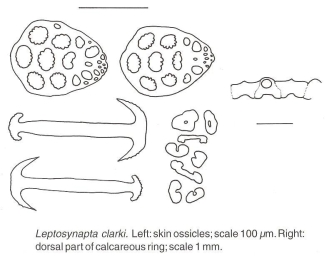clarki = Dr H.L. Clark, an eminent American echinoderm specialist
|
Adult L. clarki ingest sediment and digest the organic content, just as earthworms do. Young Leptosynapta eat diatoms on eelgrass and other seaweeds. In eelgrass beds, the population of L. clarki may reach 245 per m².
Males shed sperm from mid November to mid December. Some biologists suspect that sperm enter the female via pores in the wall of the cloaca, or via the gonopore, to fertilize the eggs. The mean diameter of mature eggs recorded in a study at False Bay, San Juan Island, was 345 μm. The same study showed the maximum number of eggs was 2,495 per female. Females brood the eggs internally from November to April. During that time, yolk from nurse eggs nourish the developing juveniles. Juveniles are 12 mm long with 12 tentacles when they are expelled through circumanal ducts that connect the body cavity to the cloaca. This species is a protandric hermaphrodite: all individuals start out as males, and about half of those later become female. The sex change occurs when the individuals are between 200 and 400 mg in weight. There is some evidence that a sex change may occur more than once in its lifetime.
The microscopic, anchor-shaped ossicles (2 to 8 per mm²) form a bulge in the skin that enables the sea cucumber to grip the sediment while burrowing.
The Sand Star (Luidia foliolata), fish, sea gulls and crabs eat Leptosynapta.
The commensal polychaete worm, Malmgrenia nigralba (= M. lunulata), and the bivalve, Scintillona bellerophon, occur with Leptosynapta clarki. S. bellerophon attaches to the host with fine threads or with its foot in 57% of specimens collected at a Sooke Harbour site. Other species often associated with Leptosynapta clarki are the burrowing brittle star (Amphiodia occidentalis) the bivalves (Macoma nasuta and Mysella tumida) the Pea Crab (Pinnixa schmitti) and the polychaete worms (Harmothoe lunulata and Pholoe minuta).
|
|

